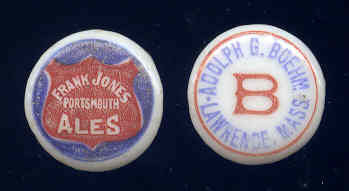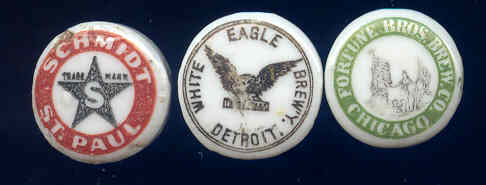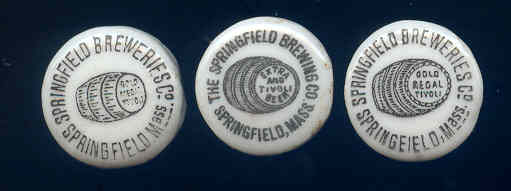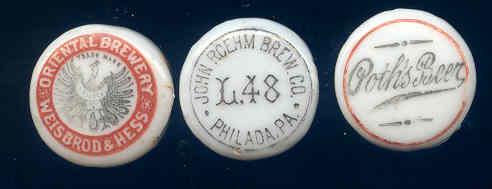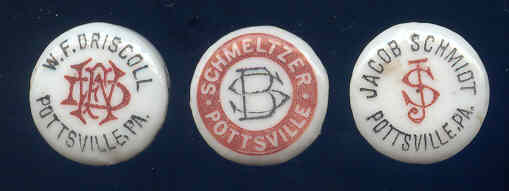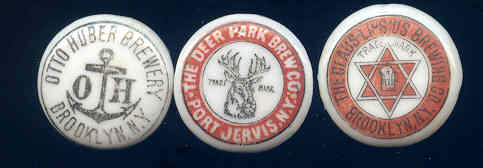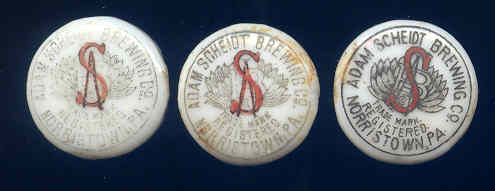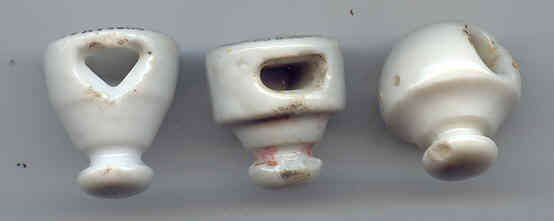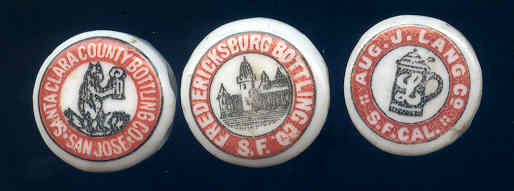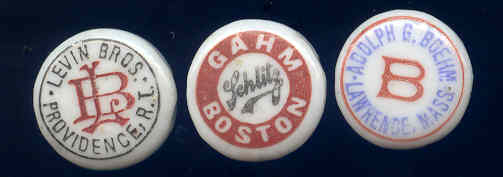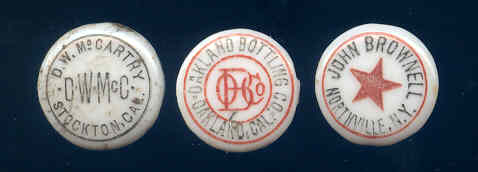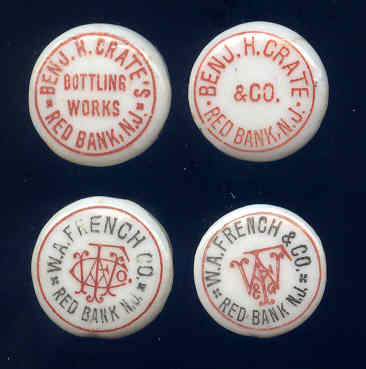An Introduction to Collecting Porcelain Beer Bottle Stoppers
(Written by Rustycans Guest writer: Tom Byrne, ECBA #729, ABA # 7)
Frank Jones Ales stopper from Portsmouth, NH is unusual for its use of the color blue. Adolph G. Boehm was a bottler in Lawrence, MA who also used the rare blue color on his stoppers.
What is a beer bottle stopper?
After the civil war, glass bottles became much more available and were usually sealed with a simple cork. This worked fairly well for most bottlers, but corks would sometimes dry out or leak, and were not easy to reseal.
As the cork stopper lost favor among brewers and bottlers, many inventors worked feverishly to patent the perfect bottle sealing device. Dozens of bottle stopper patents were issued to eager inventors who were hoping to cash in on the latest mechanical marvel. Meanwhile, the population was increasing dramatically, breweries were opening everywhere and the demand for refillable bottles was ever increasing.
Prior to 1900, nearly all glass bottles were custom made with raised-letters and graphics which proudly stated the name, address and logo of the “owner” of each bottle. These bottles were semi-hand-made and were certainly intended to be filled and returned many times during their lifetime. Bottles made prior to 1900 typically have some sort of bulbous mouth on them which could be designed specifically to accommodate a particular type of patented bottle stopper.
It was very expensive for most pre-prohibition breweries to add their own bottling line to their plant. Not only were the bottles expensive, but the manpower and space needed for a bottling plant was prohibitive in these early years for many companies. To make things more complicated for a brewery owner, the various patented bottle stoppers were ever-changing. This would often render bottling equipment and bottle types obsolete long before their time. In many areas, there were laws prohibiting a brewery from also owning their own bottling company. In other areas, the bottling plant had to be completely separate from the brewing facility even if both were owned by the same parent company. Many early breweries chose to solve this problem by outsourcing their bottling processes to a local bottling company.
In many cases, a brewery could expand their distribution area significantly by contracting with a distant bottling company to package and distribute their beers in a distant market. Gahm’s was a bottler from Boston, MA who bottled Schlitz Beer which was brewed in Milwaukee. Anheuser Busch Brewing Association had their St. Louis brewed beers bottled at local bottlers around the country including one in Somerville, New Jersey. The railroad industry was extremely efficient at moving fresh-brewed beer quickly to distant bottlers around the country.
Lightning Stopper, circa: 1875-1920, Invented by: Charles De Quillfeldt
Patent Date: January 5, 1875
This stopper revolutionized beer bottling and was an almost instant success for Karl Hutter who acquired the patent rights and popularized this efficient bottle stopper in 1877. There were many imitators of this patent over the years, but they all worked on the same principle of sealing the mouth of a bottle with a swing-away, multiple-use, rubber gasket. This lightning stopper was used from the mid 1870’s until the onset of national prohibition in 1920. Embossed bottles with this type of stopper are commonly found at flea markets, antique bottle shows and breweriana club events.
Hutter Stopper, circa: 1893-1920, Invented by: Karl Hutter
Patent Date: February 7, 1893
This stopper was an improvement to the Lightning stopper and was extremely popular and eventually replaced the Lightning as the preferred beer bottle stopper. A cone-shaped porcelain stopper was fitted with a rubber washer on the narrow end and forced into the narrow mouth of the bottle to seal it. Innovative printing technology in the very late 19 th century allowed brewers and bottlers to have their company name, address, and a logo or monogram imprinted on top of this Hutter stopper. Many examples of embossed bottles can be found with their original Hutter stopper still intact. Loose stoppers have been dug by countless bottle diggers in dumps and privies from New England to California over the years. Note the patent information that is carefully printed on the narrow end of the stopper: “Patented K. Hutter Feb. 7, 1893.” This stopper was eventually replaced with the Crown Cap.
These three brewery issued stoppers are from the Midwestern states. Schmidt from St. Paul, MN, Fortune Bros from Chicago, IL and White Eagle from Detroit, MI.
Crown Cap Stopper, circa: 1892-1960, Invented by: William Painter
Patent Date: February 2, 1892
Painter was a great inventor of many things that related to the bottling industry. The Crown Cap was a unique and industry-changing invention. It was a simple, single-use, economical and effective bottle seal. The Crown Cork had a corrugated-flange edge, and it was lined with a thin cork disc and a special paper backing to seal the bottle and also to prevent contact between the metal cap and the beverage.
Painter had to work hard to convince the bottle manufacturers to accept the Crown Cap design. The bottles in use at the time were all semi-hand-made “blob top” bottles that used the Lightning, Hutter, or another patented bottle stopper. For the Crown Cap to be able to work correctly, the bottle had to have the familiar “crown top” style lip that is commonly seen today. At this same time, the “automatic bottle making machine” was invented and was widely accepted by the glass industry. Finally, by about 1920, the crown cap was adapted by nearly all American glass bottle manufacturers and the Lightning and Hutter porcelain stoppers were forever discontinued in the USA.
- If your interests lie with collecting international breweriana, you should know that the Hutter porcelain stoppers are still being used by many breweries throughout Europe. Stopper collectors in Europe have a very well established hobby and much is known about the thousands of stopper variations and the breweries and bottlers who use them. Visit this website for a close-up look at the wonderful porcelain stoppers that are found in Europe. www.plopsite.de/engl-index.html
Collecting Stoppers
Now that you know the origin of these porcelain stoppers, what should you know about collecting them?
Porcelain bottle stoppers can be collected based on any individual’s criteria. Many collect all stoppers from breweries and bottlers from all over the USA. If you want to limit your collection somewhat, here are some ideas on how YOU can build a fine collection:
1. Collect all porcelain stoppers that are printed with a brewery name. Sometimes they will have the word “brewery” abbreviated as “Brg” or “Bw’g” or other creative ways to save space on the stopper. Since all American porcelain stoppers are Pre-Prohibition, you may not recognize some of the brewery names. Having a copy of the book “American Breweries II” can really be tremendously helpful in helping identify exactly where, when and by which brewery your stoppers were used.
Springfield Breweries, Springfield, MA: Note the subtle differences in the barrel and the wording on these three brewery stoppers.
2. Many choose to collect all porcelain stoppers from breweries and bottlers from one geographic area, such as Philadelphia, PA. Once again, be on the lookout for abbreviations of the city name. I have seen Philadelphia written as “Phila” or “Philada” quite often. Look for subtle variations in the names or addresses of the companies listed on the stoppers. Often, streets are re-mapped, re-named, and companies expanded or moved during their business lifetime. Many companies changed names as new partners came in or when sons joined dad’s business.
Philadelphia stoppers: Famous for its “Brewerytown” section, Philadelphia is home to many different stopper variations. Included here are three brewery issued Philly stoppers: Weisbrod and Hess, Roehm and Poth.
3. If you collect a certain breweries’ advertising only, don’t forget to seek out all variations of their porcelain bottle stoppers as well. There are many who enjoy collecting Anheuser Busch advertising. Although very scarce, A-B made porcelain stoppers with variations of the famous “A” and “eagle” logo. Also, I’ve seen several A-B stoppers with their local bottlers address on them. It is an enjoyable treasure hunt to find a porcelain stopper marked with the name and logo of YOUR favorite brewery.
Pottsville, PA: Three colorful stoppers from different bottlers in Pottsville, PA. Keep an eye open for porcelain stoppers from local small and mid-sized towns near you.!
4. A colorful and historical collection is made when you specialize in collecting stoppers that are still attached to their original bottle. These are quite often found at bottle shows, flea markets and breweriana shows. Some bottles with their stoppers come out of old attics, barns, and sealed up walls in houses. Sometimes the bottles were purposely hidden away and forgotten. Other times, they were emptied and tossed aside carelessly. Either way, a well preserved bottle with its original wires and stopper is a cherished artifact of our brewing past.
5. Don’t overlook a collection of stoppers which feature “stars,” “eagles” or other icons. While most stoppers have just a name and an address, some do have interesting monograms or logos. It won’t be too long before you find some depicting a barrel, or a figure of an animal, a crown, a person, an anchor, etc. No matter how broadly you collect, having a few stoppers with “pictures” on them makes a collection more interesting.
These three brewery issued stoppers come from New York. The Otto Huber and the Claus Lipsius are from Brooklyn, the Deer Park is from Port Jervis.
Now that you have a good idea of what stoppers are and how YOU might start a collection, let me give you some tips and techniques to help get YOUR collection started on the right foot:
Grading Stoppers:
"STRONG" = all copy and graphics are completely legible, clearly printed in dark shades of black, red or orange.
"AVERAGE" = most copy and graphics are completely legible; some printing may fade and be somewhat difficult to read.
"WEAK" = most copy and graphics are very faintly printed, and may require very close scrutiny to be legible. These "weak" examples are though of as "place holders" in a collection until an "average" or "strong" example of the same stopper can be obtained.
"BLANK" = a porcelain stopper that never had copy imprinted on the top surface. This may be considered a generic stopper and could have been used for some cost savings by a brewer/bottler or until the next shipment of imprinted stoppers was obtained.
“Weak”, “Average” and “Strong” Grades: Note the condition of these three Adam Scheidt Brewery stoppers from Norristown, PA. Commonly found in different “Grades,” stoppers are collectible as long as the writing on them can be read. Naturally, prices are generally higher for better grades, much like with rare coins. Variations:
Shapes:
- Conical- a tapered cone-shaped stopper with a broad flat surface at the top end and a pointed “nipple” at the opposite end which was fitted with a rubber gasket.
- Cylindrical- a variation of the conical stopper except that the sides are parallel with each other. There is with a broad flat surface at the top end and a pointed “nipple” at the opposite end which was fitted with a rubber gasket. This variation is rather commonly found. Often you will find conical and cylindrical shaped stoppers with the same name and graphics on them.
- Spherical- a round, ball-shaped stopper with a pointed “nipple” at one side which was fitted with a rubber gasket. These are somewhat rarer than cylindrical or conical stoppers.
Design:
- Typeface- Observe the lettering on stoppers and you will notice various type styles, boldness, sizes and spacing of characters. The logos or monograms often exhibit slightly different designs from one stopper to another.
- Color- Many stoppers are printed in either all “black” or all “red” ink. In some cases, you can find two stoppers where the text and graphics are identical, but the ink color has changed. Also, you may find one stopper that is printed in “black” and another with the same text and graphics that is both “red” and “black.”
- Address or name changes-As stated above, watch for changes in company name or location when comparing stoppers that you find. If you store your stoppers alphabetically by company name, you can easily sort out these variations very quickly.
- Logo or monogram changes- When comparing two stoppers, take a look at the pictures and monograms. Often there will be details in the artwork that differ between two “similar” stoppers.
Three colorful “picture stoppers” from California. Lucky for us collectors, the stoppers from California are rather plentiful. It is the stoppers from the other western states that are much tougher to find. Cleaning Stoppers:
Stoppers are often dug in town dumps, privies and found in long forgotten buckets in the basements of bottle diggers. Usually, hot, soapy water and a liberal scrubbing with bottle brushes are all that’s needed to clean up these antiques. Don’t ever use Brillo pads or some other abrasive sponge or material to remove more dirt faster! I’ve done it, and ruined a good brewery stopper by literally scrubbing the text and graphics right off! Soaking stoppers in hot, soapy water overnight will usually soften material that is clogged in the crevices of the stopper. I use an old nut pick and dental tools along with needle-nose pliers to pick out rusty wire remnants, and other material that gets stuck inside the hole in the stopper. Naval jelly is a rust remover that may have limited good results with removing stains. Recently, other collectors have recommended “oxalic acid” and “hydrogen peroxide” as two chemicals to try for removing rust or stains. Please follow the instructions on these packages very carefully as both chemicals are poisonous and hazardous. In all cases, please practice with common stoppers before you run the risk of damaging or destroying a very rare item!
These stoppers are from bottlers in Rhode Island and Mass. Note the unusual blue lettering on the Boehm stopper from Lawrence, MA. Displaying Stoppers:
I enjoy looking at my collection frequently and have my stoppers sorted out by state. I can look at each stopper through the glass lid of those handy black cardboard cases called “Riker Mount Cases.” You’ll see flea market dealers with these on their tables containing small and valuable things like watches or coins. The top of the case, or lid, slides up and off of a slightly smaller cardboard case. Four steel pins fit into tiny holes at the corners of the assembled case to hold the lid in place. These cases can be purchased at larger antique shows or via the internet from dealers of plastic sleeves, tags, labels, etc.
My collection currently is displayed in wooden racks which are sized to fit snuggly inside a Riker Mount Case. These wooden racks are drilled with a series of different sized drill bits to create 88 “cone shaped” holes equally spaced in 8 rows of 11 holes. These racks are a bit costly and time to make, but they are permanent and do allow you to move the stoppers around to keep everything organized as your collection grows.
A less expensive way to proceed includes using Styrofoam sheets which are commonly available from a craft store retailer. I found 1” thick Styrofoam sheets without any problem and custom sized the sheet to fit within the Riker Mount Case. Using a template, I was able to poke small holes in the Styrofoam at regularly spaced intervals. These holes provided a rather snug fit for the small end of the stopper to rest. Do some experimenting of your own with the size holes to use and the spacing that works best for your own collection.
A wonderful way to display your stoppers is to have them sitting on top of their original bottle. Whether you found a bottle with the stopper intact or were able to marry a loose stopper and bottle together, they look terrific when displayed together. Keep those stoppers out of direct sunlight though. I was recently reminded that the colors used to create the old lettering on stoppers may become faded when exposed to direct sunlight. Better to be safe than sorry!
Small stoppers: McCarthy, Oakland Bottling and Brownell stoppers are all from small capacity bottles. These stoppers measure just over ¾” diameter rather than the standard 1” diameter.
Values for Stoppers:
Weak grade stoppers can be purchased for .25 to $1.00 each. (These are often “place-holders” in one’s collection until a more strongly printed stopper can be obtained.)
Average grade stoppers can be purchased for $1.00 to $4.00 each. These can cost significantly more for a “brewery” stopper or one from a “scarce” state, town, or one with unusual colors or graphics. An example of this was found during the ABA National Convention in Pittsburgh this past June. One example of an Eberhardt and Ober Brewing Co, Allegheny, PA stopper turned up for $12.00. It was somewhere in between “weak” and “average” condition. Due to the “local demand”, it sold twice for $12.00 in the course of the day and ended up in the hands of a local Pittsburgh, PA collector.
Strong grade stoppers can be purchased for $1.00 to $10.00 each. (See note above regarding “local collector demand” and its impact on prices!)
If the stopper is still attached to its bottle, add between $6 and $20 for the bottle itself and the novelty of having an intact breweriana artifact. These bottle-stopper combinations make excellent additions to ones breweriana collection no mater whether one is a stopper collector or not! Good Collecting!
South Jersey bottlers: Benjamin Crate and W.A. French were major bottlers in Red Bank, NJ. Notice the subtle variations in the name of the company and the monogram.
Author Biography:
Tom Byrne is a member of the ABA and the ECBA and has been collecting beer bottle stoppers for just over 2 years. His collection consists of over 650 different U.S. stoppers from breweries and bottlers. He lives near Philadelphia, Pennsylvania and attends breweriana and bottle collector shows throughout the Northeastern and Middle Atlantic states. He is currently building a website with information and photos to help collectors worldwide to better understand this growing hobby.
Author’s contact information: I’ll be happy to answer any questions that you have if you will email me or write and please enclose a self addressed stamped envelope. Please use the contact information below.
Tom Byrne
53 S. 3 rd Street, Perkasie, PA 18944
Phone: 215-453-9530
Email: Runninghorse1@verizon.netBottle Stopper Website: under construction – email Tom to get on mailing list.

